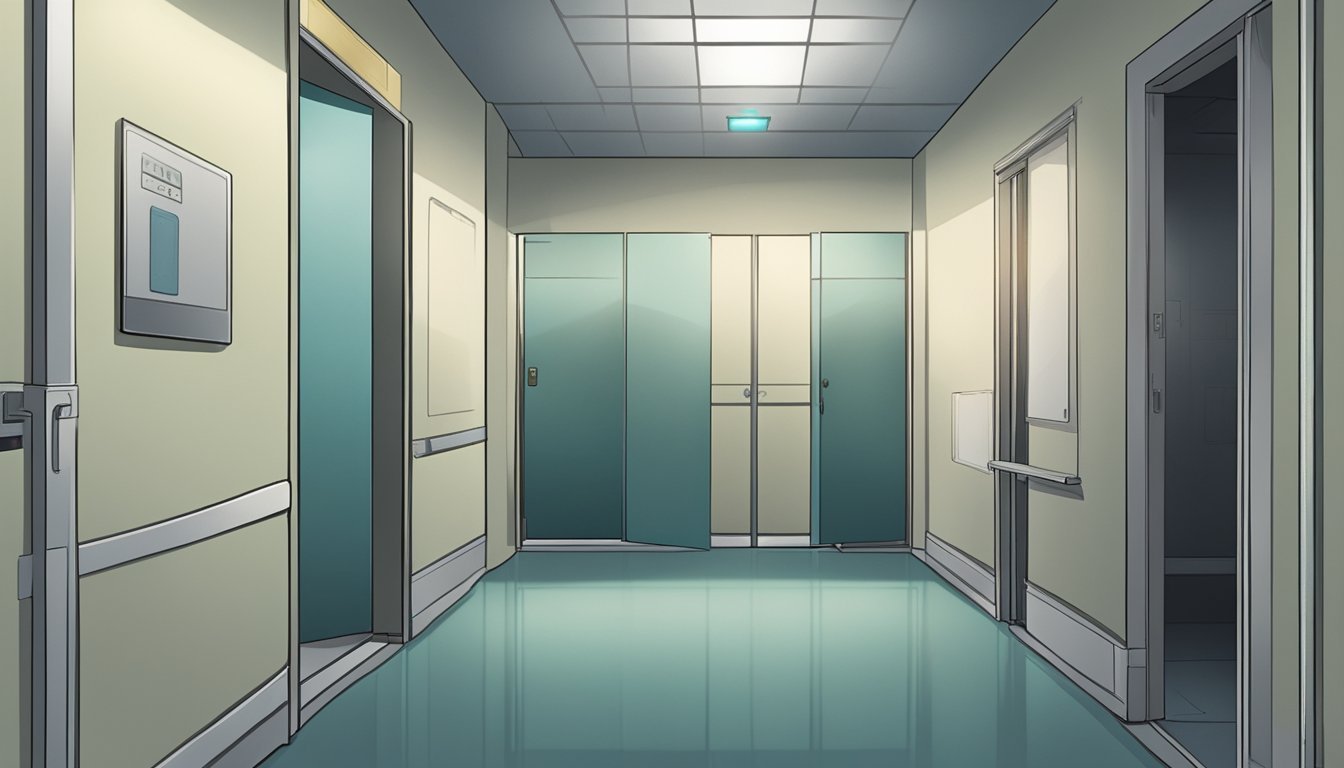Efren Saldivar's Nightshift Ends: Hospital Angel of Death Dies of Natural Causes at 55
Efren Saldivar, a former respiratory therapist at Glendale Adventist Medical Center in California, gained infamy as the "Angel of Death" for his chilling crimes during the 1990s. Saldivar confessed to killing between 6 and 50 patients during his night shifts, using his medical knowledge to end lives rather than save them.
His reign of terror came to an end in 1998 when he was arrested following a confession to authorities. Saldivar's case shocked the medical community and raised serious questions about hospital security and patient safety. The victims were primarily elderly patients under his care, making his actions all the more heinous.
Saldivar's crimes highlight the vulnerability of patients in healthcare settings and the potential for abuse of power by medical professionals. His case led to increased scrutiny of hospital practices and stricter protocols for monitoring staff, especially during night shifts when supervision is often reduced.
Profile of Efren Saldivar
Efren Saldivar, a former respiratory therapist, gained notoriety as the "Angel of Death" for his crimes at Glendale Adventist Medical Center. His case shocked the medical community and raised concerns about patient safety in healthcare settings.
Early Life and Career
Efren Saldivar was born on September 30, 1969. He pursued a career in healthcare, becoming a respiratory therapist. Saldivar began working at Glendale Adventist Medical Center in California in the late 1980s.
Initially, he appeared to be a dedicated healthcare professional. Colleagues described him as competent and unremarkable. Saldivar's career choice suggested a desire to help patients and contribute to their well-being.
Turn to the Night Shift
Saldivar transitioned to working night shifts at the hospital. This change proved pivotal in his descent into criminal behavior. The night shift offered less supervision and more opportunities for unsupervised patient contact.
During these quiet hours, Saldivar's actions took a sinister turn. He began targeting vulnerable patients, particularly the elderly and terminally ill. The cover of darkness and reduced staffing allowed him to carry out his crimes undetected for years.
Alias: Hospital Angel of Death
Saldivar's crimes earned him the chilling moniker "Angel of Death." He confessed to killing between 40 and 50 patients from 1989 to 1997. His method involved injecting patients with paralytic drugs, causing respiratory failure.
Saldivar's actions were discovered in 1998 when he confessed to a friend. This led to a police investigation and his arrest. Forensic evidence later confirmed his involvement in at least six deaths.
In 2002, Saldivar pleaded guilty to six counts of murder. He received a sentence of life in prison without the possibility of parole. His case highlighted the need for increased vigilance in healthcare settings to protect vulnerable patients.
Timeline of Murders
Efren Saldivar's killing spree spanned several years at Glendale Adventist Medical Center. His actions resulted in numerous patient deaths, primarily during night shifts.
First Known Incidents
Saldivar's murders began in the late 1980s. He targeted elderly patients, often those already in critical condition. His first confirmed victim was an 82-year-old man in January 1997.
Saldivar administered lethal doses of medications or cut off patients' oxygen supply. He claimed to have killed out of mercy, but investigators found no evidence supporting this assertion.
Patterns of Patient Deaths
A suspicious pattern emerged during Saldivar's night shifts. More patients experienced cardiac arrest or sudden deterioration when he was on duty.
Hospital staff noticed an increase in deaths during Saldivar's shifts. However, initial concerns were dismissed due to the nature of critical care work.
Saldivar's victims ranged in age from 75 to 87. Most were recovering from surgeries or respiratory issues.
Escalation and Suspicion
By the mid-1990s, Saldivar's actions became bolder. He confessed to killing between 40 and 50 patients, though the actual number remains uncertain.
Colleagues began to suspect foul play. They noticed Saldivar predicting patient deaths with uncanny accuracy.
In 1998, an anonymous tip led to an investigation. Saldivar was questioned and initially confessed, but later recanted. He was arrested in January 2001 after evidence linked him to specific murders.
Prosecutors ultimately charged Saldivar with six murders. These cases had the strongest evidence, including traces of paralyzing drugs in exhumed bodies.
The Killings
Efren Saldivar's murderous actions as a respiratory therapist shocked the medical community. His methods were calculated and difficult to detect, utilizing drugs meant to help patients in sinister ways.
Modus Operandi
Saldivar targeted elderly or terminally ill patients during night shifts at Glendale Adventist Medical Center. He injected victims with paralytic drugs, causing respiratory failure. This made deaths appear natural, as patients were already in poor health. Saldivar often acted when other staff were busy or on breaks. He selected victims he deemed beyond recovery, appointing himself as judge and executioner.
Choice of Drugs
Saldivar primarily used two paralyzing drugs: Pavulon and succinylcholine chloride. Pavulon, a muscle relaxant, causes paralysis including of respiratory muscles. Succinylcholine chloride produces similar effects but acts more quickly. Both drugs leave little trace in the body, making detection challenging. These medications are commonly used in medical settings, allowing Saldivar easy access. He diverted small amounts over time to avoid raising suspicion.
Euphemism: Magic Syringe
Saldivar referred to his lethal injections as the "magic syringe." This chilling euphemism revealed his detached attitude toward killing. He viewed the syringe as a tool to end suffering, though his victims never consented. The term also hinted at the swift, seemingly inexplicable nature of the deaths he caused. Saldivar's "magic syringe" contained a lethal cocktail of drugs that quickly and quietly ended lives, leaving little evidence behind.
Investigation and Arrest
The investigation into Efren Saldivar's crimes spanned several years, involving multiple agencies and complex forensic analysis. His eventual arrest came after a detailed confession and damning evidence linked him to numerous patient deaths.
Initial Whistleblowers
In March 1998, an anonymous tip alerted Glendale Adventist Medical Center to suspicious patient deaths. The hospital launched an internal investigation, interviewing staff members and reviewing patient records. Several coworkers reported concerns about Saldivar's behavior during night shifts. One nurse recalled seeing him enter patients' rooms without reason and inject substances into IV bags. The hospital suspended Saldivar and notified the Glendale Police Department.
Glendale Police Involvement
Glendale police formed a task force to investigate the allegations. Detectives interviewed hospital staff, patients' families, and reviewed hundreds of medical records. They faced challenges in distinguishing between natural deaths and potential murders due to the victims' ages and health conditions. Forensic experts examined tissue samples from exhumed bodies, looking for traces of drugs like succinylcholine and Pavulon.
The investigation expanded to other hospitals where Saldivar had worked. Police created a database to track suspicious deaths during his shifts.
Breakthrough and Confession
In January 2001, police arrested Saldivar after new evidence emerged. Forensic analysis by Lawrence Livermore National Laboratory detected traces of Pavulon in exhumed bodies. Under questioning, Saldivar confessed to killing between 100 and 200 patients. He admitted to injecting them with paralytic drugs or suffocating them.
Saldivar's detailed confession provided crucial information about his methods and motives. He claimed to have acted out of misguided mercy for terminally ill patients. The confession, combined with forensic evidence, led to formal charges for six murders.
Legal Proceedings
Efren Saldivar faced serious criminal charges for his actions at Glendale Adventist Medical Center. His case progressed through the legal system, culminating in a plea bargain and life sentences.
Criminal Charges
In January 2001, prosecutors filed charges against Saldivar. He faced six counts of first-degree murder with special circumstances. The victims were elderly patients under his care at the hospital. Authorities also charged him with one count of attempted murder. These charges stemmed from a lengthy investigation that began after Saldivar's initial confession in 1998.
Trial and Plea Bargain
Saldivar initially pleaded not guilty to all charges. As the trial approached, prosecutors sought the death penalty. In March 2002, Saldivar changed his plea to guilty. This plea bargain allowed him to avoid capital punishment. By admitting to the murders, Saldivar spared the victims' families a lengthy trial process.
Sentencing and Aftermath
On April 17, 2002, a Los Angeles court sentenced Efren Saldivar to six consecutive life terms without the possibility of parole. The judge also imposed an additional life term for the attempted murder charge. Saldivar was remanded to the California State Prison system to serve his sentences. His conviction brought closure to the families affected by his crimes and ended his career as a respiratory therapist.
Impact on Victims' Families
The murders committed by Efren Saldivar devastated numerous families, leaving them grappling with grief and a profound sense of betrayal. Their quest for justice and closure shaped public perception of the case.
Public Reaction
News of Saldivar's crimes sent shockwaves through the community. Many expressed disbelief that a healthcare professional could betray patient trust so horrifically. Families of patients who had died at Glendale Adventist Medical Center during Saldivar's tenure faced agonizing uncertainty.
Some worried their loved ones might have been victims. Others struggled with guilt for not questioning earlier deaths. Media coverage intensified public outrage and sympathy for the victims' families.
Families Seeking Justice
Relatives of confirmed victims pursued legal action against both Saldivar and the hospital. They demanded accountability and systemic changes to prevent future tragedies. Several families testified at Saldivar's trial, sharing emotional impact statements.
Their words painted vivid pictures of lives cut short and dreams unfulfilled. Many expressed relief at Saldivar's life sentence but noted it could never truly compensate for their losses. Support groups formed, allowing families to connect and heal together.
Advocacy efforts by victims' families led to increased scrutiny of hospital hiring practices and patient safety protocols nationwide.
Scientific and Medical Analysis
Advanced forensic techniques and toxicological examinations played a crucial role in uncovering Efren Saldivar's crimes. These methods provided critical evidence that led to his conviction.
Toxicology and Autopsies
Toxicology tests were essential in identifying the presence of lethal substances in the victims' bodies. Autopsies revealed traces of paralytic drugs, particularly Pavulon, in exhumed remains. This muscle relaxant, when administered in high doses, can cause respiratory failure.
Investigators exhumed multiple bodies of suspected victims for thorough examination. The decomposition process complicated the analysis, but forensic experts employed specialized techniques to detect drug residues.
The toxicology results showed consistent patterns across several cases, strengthening the evidence against Saldivar.
Role of Forensic Science
The Forensic Science Center at Lawrence Livermore National Laboratory played a pivotal role in the investigation. Their advanced analytical methods detected minute traces of Pavulon in tissue samples.
This breakthrough provided crucial physical evidence linking Saldivar to the murders. The center's director, Brian Andresen, developed a highly sensitive test specifically for this case.
The forensic team's work allowed prosecutors to build a solid case against Saldivar. Their findings corroborated his confession and helped identify additional victims.
The scientific evidence was instrumental in securing Saldivar's conviction and bringing closure to the victims' families.
Media Coverage and Public Interest
Efren Saldivar's crimes at Glendale Hospital sparked intense media scrutiny and public fascination. News outlets extensively covered the case, delving into the chilling details of his actions as a respiratory therapist turned serial killer.
Los Angeles Times Expose
The Los Angeles Times played a crucial role in bringing Saldivar's crimes to light. Their investigative reporting uncovered the scale of his killings and the methods he used to end patients' lives. The newspaper's expose revealed how Saldivar managed to avoid detection for years while working night shifts at Glendale Hospital.
Reporter Brian Andresen led the Times' coverage, conducting in-depth interviews with hospital staff, law enforcement, and victims' families. His articles provided a comprehensive look at the case, exploring the systemic failures that allowed Saldivar to continue his deadly activities undetected.
Documentaries and Reports
Several documentaries and television reports focused on Saldivar's case, attracting widespread viewer interest. These productions examined the disturbing nature of his crimes and their impact on the medical community.
One notable documentary, "Angel of Death: The Efren Saldivar Story," featured interviews with investigators and hospital personnel. It provided a detailed account of how Saldivar carried out his murders and the subsequent investigation that led to his arrest.
Television news programs also devoted significant airtime to the case. They explored the psychological aspects of Saldivar's actions and the broader implications for patient safety in healthcare settings.
Preventive Measures in Healthcare
Healthcare institutions implemented crucial safeguards to protect patients and ensure staff accountability. These measures aimed to prevent future incidents similar to Saldivar's crimes.
Hospital Policy Changes
Hospitals nationwide revised their protocols following the Saldivar case. Stricter medication controls were put in place, limiting access to potentially lethal drugs. Two-person verification became mandatory for administering certain medications.
Security cameras were installed in critical areas, including intensive care units and medication storage rooms. This enhanced surveillance deterred unauthorized activities and provided evidence if needed.
Hospitals also improved their reporting systems. Staff members were encouraged to voice concerns about colleagues' behavior without fear of retaliation. Anonymous tip lines were set up to facilitate this process.
Regular audits of patient deaths became standard practice. Any unusual patterns or unexpected fatalities triggered immediate internal investigations.
Screening for Healthcare Workers
Healthcare facilities intensified their pre-employment screening processes. Background checks became more thorough, encompassing criminal records and professional license verifications across multiple states.
Psychological evaluations were added to the hiring process for positions with direct patient care responsibilities. These assessments aimed to identify potential red flags in candidates' personalities or behaviors.
Ongoing monitoring of staff performance was implemented. Regular reviews included patient outcomes, medication administration records, and peer feedback.
Hospitals increased their focus on staff well-being. Support programs were established to address burnout and mental health issues among healthcare workers, recognizing these factors could impact patient care.
Continuing education requirements were expanded to include ethics training and patient safety modules. These courses reinforced the importance of professional integrity and patient advocacy.









